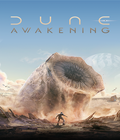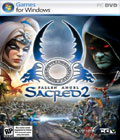Genre: Role-Playing
Publisher: CDV
Developer: Ascaron
Release Date: November 11, 2008
Diablo has cursed every other title following its formula by having the unfortunate privilege of being compared to its accomplishments. One of these was Ascaron's Sacred, which took the radical route by dropping that formula into a continent-sized sandbox. It apparently did well enough for a sequel, and Sacred 2's updated sandbox has never looked better, but there are unexpected rocks buried beneath its deceptively pretty surface.
Sacred 2's backstory takes place approximately 2,000 years before the first game, although you needn't have played it in order to understand what it's all leading up to. Ancaria's world mixes together science and sorcery with the introduction of T-Energy, a magical power with atomic consequences that everyone wants to control. With Ancaria about to fall back into the flames of war, that's where you come in.
With the addition of a "Shadow" campaign and individual origin stories for each character class, Ascaron has made it clear that it wanted a strong story as a starting point for the player. The fiction is thick with details, much of it told through books that can be discovered in-game, although sword-and-sorcery purists will have to deal with how often it breaks the fourth wall with modern quotations and direct references to the player.
It also isn't represented well elsewhere. The main campaign comes off as a string of chores more than an engaging story of one player's fight against an unseen evil; some of the quest givers are rather long-winded and may as well be writing theses on what ails them. I love a good story, but in Sacred 2's case, much of its fiction comes off as leaden, overwritten asides that often feel out of place alongside the click-fest heavy, hack-and-slash gameplay. NPCs will even deliver their dialogues in the middle of combat if you manage to click on them while you have a horde of monsters on your heels. Fortunately, your hero won't die when this happens since the conversation apparently protects them from harm. Unfortunately, it ruins the atmosphere.
The game features online activation, which allows you to play the game without the disc and was relatively issue-free, although the opening movie ran without any speech. Looking at the official forums, that's a problem that seems to be as random as the stock market and is apparently fixed by changing the sound settings to "Stereo," something I haven't had to do for any game in years. Several hundred megabytes of fixes were also applied thanks to the included patch service, so be sure to make a sandwich if you opt for it.
There are a lot of spoken lines in the game between NPCs wandering the streets and the enemies that die by your blade, packed with more of that fourth-wall humor that the game seems to relish. Most of the acting sounds as if it were read off cue cards, but there are a few gems in there to keep it from completely crushing the experience. Unfortunately, my choice of a Seraphim made me wish that Sacred 2 had a silent hero instead of a talkative one, as I wasn't sure if the actress was told to mock the Goody Two-shoes aspect of the class, or if that really was how the character is supposed to sound. When I first heard her "battle cry," I was nearly convinced that an NPC had died on-screen and I had missed it, until it happened again and I realized the horrible truth.
As for the music, there's a reason why an ad for the symphonic metal band, Blind Guardian, is inside the manual. They provide the opening song for the introductory video and, from what I was able to hear, a few other pieces within the game, including an amusing concert video using Sacred 2's engine. I say this only because the music had trouble playing, so if you're not a fan of mixing heavy rock with fantasy, you may not have anything to worry about. Whether it was because of how close the camera was to the action or something else entirely, the music would occasionally drop out of the action. Boss fights would sometimes play without any fanfare, and journeys across the world were usually done with only the sound of wildlife to keep me company. I guess the soundtrack is OK, but I'd probably have to order the OST in order to make sure.
Ascaron's artists deliver a lush land filled with an eclectic collection of climes populated by dirt paths, ruined monuments, statues, unpredictable weather, wildlife and scores of monsters all waiting to chew on the next adventurer passing by. Below, caverns filled with flaming rock and caves twisting deep beneath the earth lie in wait for anyone brave enough to explore them. It's a fantastic stage, and you almost wish that more could have been done to further engage the player with the world outside of combat. You feel as if you want to buy a house and start building up your own commercial empire a la Fable II or Morrowind, or begin poking around government buildings for secret societies to join and manipulate from the shadows, until you realize that it's all just scripted eye candy.
The player's character boasts just as much detail thanks to sophisticated armor sets, brutal new weapons, and the use of unique mounts. Special effects — in the form of shields, glowing highlights tracing artistic swirls on sword faces, and explosive light shows when a spell is unleashed against your enemies — make as much of an impression as the environment.
Players select from one of six classes. The celestial Seraphim is the only class to make a return from the first Sacred and is positioned as the easiest to use and play, ideal for beginners or for veterans. The other classes are no less powerful, and many of them are able to choose between a Light or Shadow campaign, with obvious exceptions. Players will also need to pick a god for their character, which plays into a special "god power" that they can invoke during play, and then pick from two difficulty levels. A Hardcore mode can also be enabled from the outset, for those savoring a real challenge with permanent character death.
Gameplay is familiar to anyone that has previously played an action RPG, such as Diablo. Once you have your character ready to go, you lead him throughout the world with your mouse and click on foes in the hopes that they will quickly die. Slots can be customized with weapons and spells, allowing you to switch them depending on the situation, and a deep skill system allows you to develop your hero in whatever fashion you wish as they level up. Enemy difficulty scales within each area to a point in order to ensure a smooth challenge, although Ancaria's open world can easily kill you if you wander too far off the beaten path. As long as you're not playing at the Hardcore setting, though, your character will return to life at the nearest resurrection monolith that you had hopefully remembered to activate. Multiplayer co-op and PvP round out the package for players hoping to share their adventures together or in competition.
Yet several pieces of Sacred 2's gameplay feel as if the developers had ignored the advances made by its peers such as Titan's Quest, most notably in the way it handles some of the hack-and-slash chores associated with the tubs of loot that your hero will often be overloaded with. There's no personal town portal or similar device to transport yourself from location to location for quick and easy access to a cache and a store, although the game allows you to immediately trash items at less than half their cost from the inventory screen. You also have to sort through piles of loot quickly because everything that drops is timed, in seconds, to disappear after so long, which can be irritating if you haven't kept up on your inventory management chores.
Resurrection monoliths and fixed portals are a poor substitute for something that its peers have wisely ignored in order to give the player a greater sense of freedom by streamlining the back-and-forth between them and the nearest personal depot. There's a lot of time-wasting travel done in the game, seemingly advertising how large Ancaria is, even with mounts. Players can expect to often grapple with the decision on whether or not to give up their progress by teleporting to the most recent resurrection monolith or trash what they have for pennies and keep pushing ahead.
The sandbox approach also doesn't work well for Sacred 2 in the same way that it has for titles such as Morrowind, Oblivion, and even Two Worlds because of its singular hack-and-slash focus. With random loot found everywhere and statistics determined by leveling as opposed to discovering a secret master out in the wild who might teach the character a forbidden art, venturing off of the beaten path is treated only as an excuse in forcing the player to experience more hack-and-slashing stretches of gameplay as he runs from one location to the next or tries to make it back to where he had teleported from.
Many sidequests also seem drawn from the school of MMORPG repetition with NPCs asking for 20 pelts, 15 hearts, or for you to kill ten bandits or to deliver a letter halfway across the continent. Still, if you love helping NPCs and killing monsters, Sacred 2 comes packed with dozens of side quests designed to help you forget about the main story and satiate your bloodlust. Many NPCs will even have something else for you to do after you finish your first job for them with rewards such as coins, experience, and even items.
You also might never know when someone will follow you until you accept the job. This poses a problem, since you can't really order around your AI companion and he often loves running straight into trouble. The good news is that when you use a potion to heal yourself, you end up healing him, too. The bad news is that early on, many of them have the consistency of papier-mâché so if they die, you can say goodbye to that side-quest. Oddly enough, key characters who are related to the main story and tag along are as tough as titanium.
There really is a lot to like about Sacred 2, but only as long as you are willing to put up with the constant need to micromanage your journey with a high tolerance for FedEx-type questing. For players who can't get their fill of killing hordes of monsters and collecting loot no matter what the local NPC may ask them to do for it, opening the nearest portal to Ancaria's past might just be the thing that their sword arm or wizardly aspirations will enjoy as the perfect distraction.
Score: 7.2/10
More articles about Sacred 2: Fallen Angel










 Sacred 2: Fallen Angel is an action RPG with a rich story that takes place in a giant, open-ended and seamless world. This world contains hundreds of dungeons, treacherous opponents and a variety of challenging quests. Intelligent enemies challenge in heroic single- and multiplayer battles.
Sacred 2: Fallen Angel is an action RPG with a rich story that takes place in a giant, open-ended and seamless world. This world contains hundreds of dungeons, treacherous opponents and a variety of challenging quests. Intelligent enemies challenge in heroic single- and multiplayer battles.































